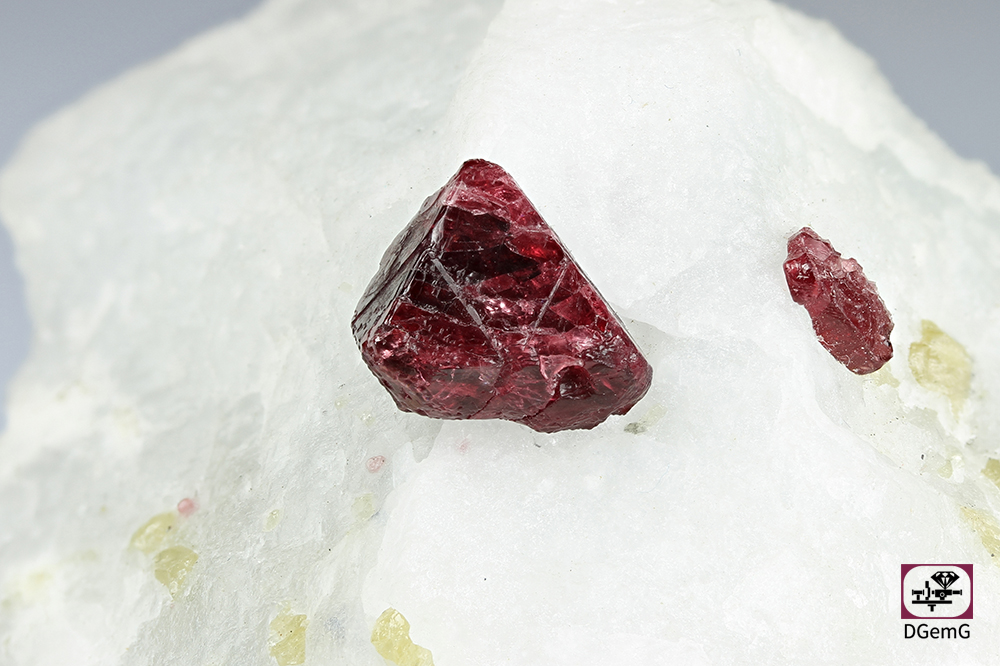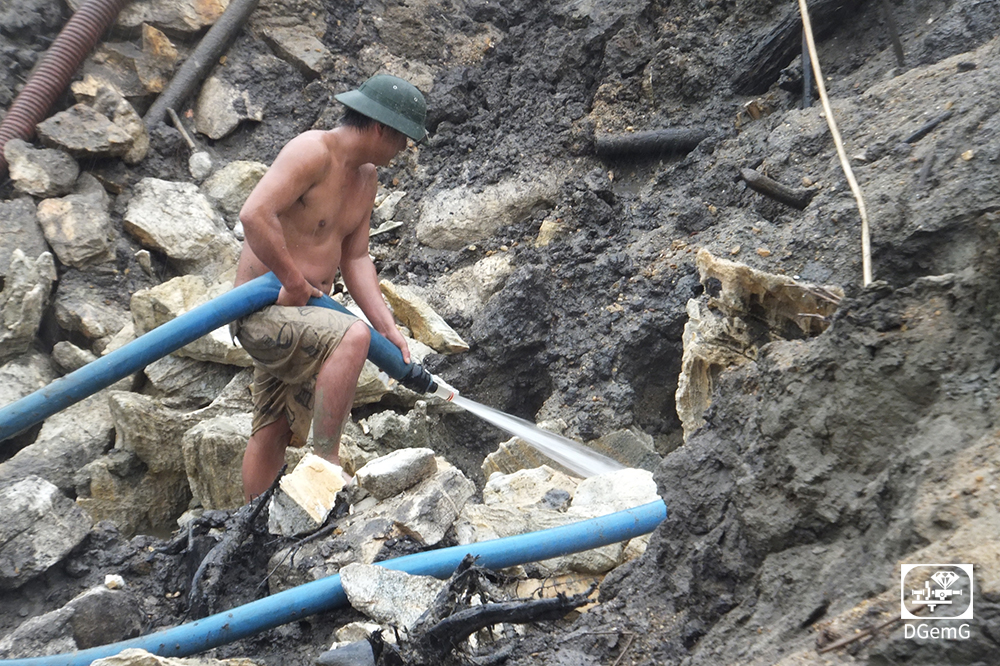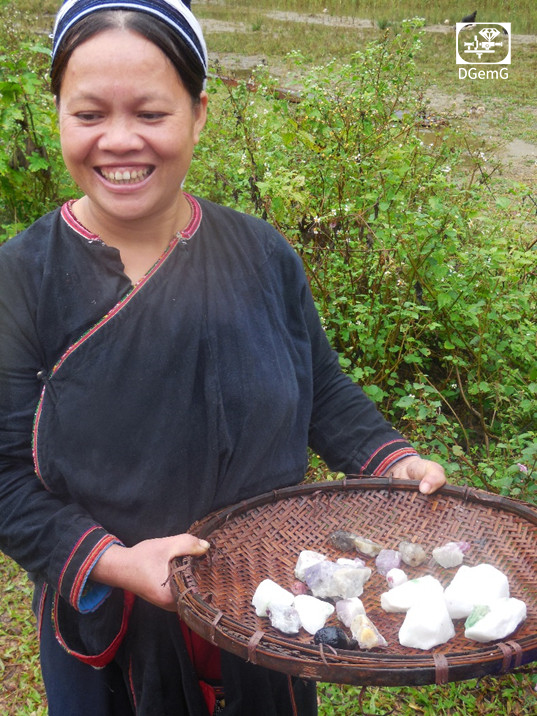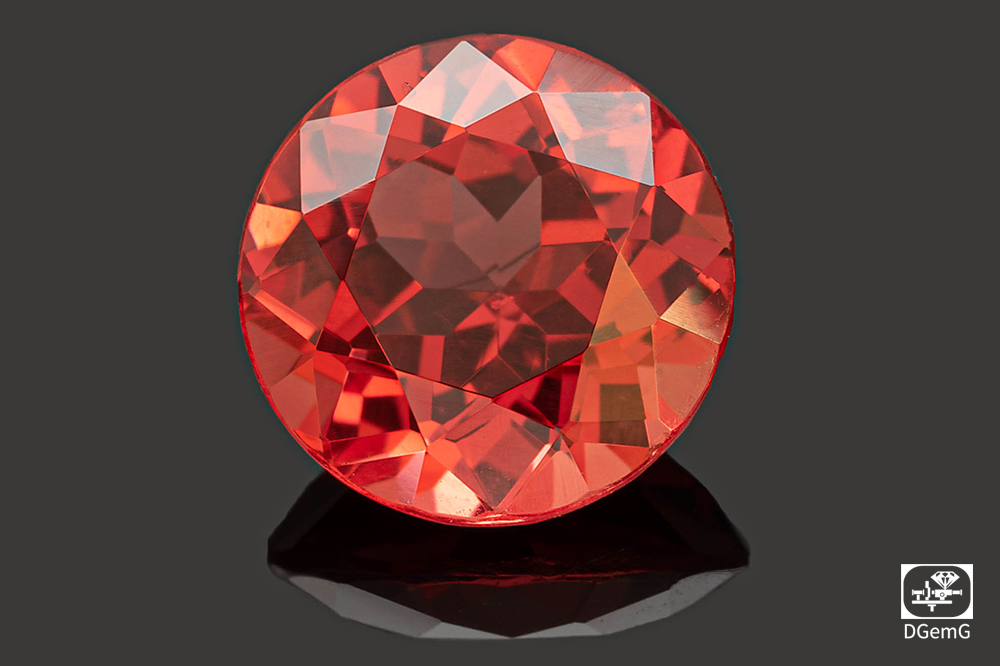The name spinel can be traced back to the 16th century. It was mentioned for the first time in 1533 by C. Leonardi, and Georg Agricola (1494-1555) wrote in "De Natura Fossilium": "If carbuncle shows a marvellous red colour and a splendid lustre, it is called spinel". The origin of the name retraces to the Greek spinther = spark, because of the "fiery" red colour, or the Latin spina = thorn, point, which probably refers to the octahedral shape of the crystals. Some spinel octahedrons are so perfect that in Myanmar (Burma) they are said to be "nat thwe", "polished by spirits".
 Spinel octahedron in marble. Photo: DGemG
Spinel octahedron in marble. Photo: DGemG
In the Middle Ages, the term carbunculus (carbuncle) was used for red stones. Albertus Magnus (1193-1280) used the term rubinus for today's ruby, granatus for the red garnet and balagius for the red spinel. The latter led to the term balas ruby, which was used specifically for red spinels from Badakhshan.
 Spinel mining in Vietnam. Photo: U. Henn
Spinel mining in Vietnam. Photo: U. Henn
Ancient Badakhshan, located in what is now the border region between northern Afghanistan and Tajikistan, is the origin of famous red spinels, which were long regarded as "rubies". These include the Samarian Spinel (500 ct, Persian crown jewels), the "Ruby" of Catherine the Great (398.72 ct, Tsar's crown), the "Timur Ruby" (352.50 ct) and the "Black Prince's Ruby" (approx. 140 ct), both part of the British crown jewels, as well as the Catherine Spinel (146.43 ct).
 Selling of rough stones in Vietnam. Photo: U. Henn
Selling of rough stones in Vietnam. Photo: U. Henn
The fact that red spinels have been equated with rubies for centuries has several reasons. Firstly, they are very similar in colour, which is also the case with blue spinel and sapphire, and secondly, they are found in the same deposits due to comparable conditions of gemstone formation. In addition, before 1800 it was not possible to differentiate between the two mineral types in terms of crystal chemistry.
Even today, it is the red spinels in particular that are in demand, especially bright red specimens with strong fluorescence, which are marketed primarily in China as "Jedi spinels", in reference to the red laser swords in the Star Wars films.
 Orange Spinel (1.54 ct). Photo: DGemG
Orange Spinel (1.54 ct). Photo: DGemG
The red colour is due to traces of trivalent chromium. Besides Tajikistan (formerly Badakhshan), significant deposits can be found in Myanmar (Burma), Tanzania, Vietnam and Sri Lanka (formerly Ceylon).
In addition to the typical bright red colour, traces of chromium also produce a broad spectrum of pink, orange and purple tones. Chromium together with iron results in mauve or lavender colours, these special spinels come mostly from Sri Lanka or Myanmar (Burma). The red colour shades are known commercially as "crimson", "rose" (pink to pink-orange) and "carmine" or purple-red.
 Blue Cobalt Spinel (6.99 ct) Photo: DGemG
Blue Cobalt Spinel (6.99 ct) Photo: DGemG
Red as most desirable and typical colour is followed by blue. Blue is generally due to iron as a trace element. Especially attractive bright blue colours are produced by divalent cobalt. The origin of such cobalt spinels is Sri Lanka, Vietnam and, more recently, Tanzania. In the trade, the colour of such stones is often called "neon electric blue" or "denim blue".
The demand for spinels, especially bright red and blue coloured stones, has increased in recent years. Eye-clean stones weighing over 10 ct are extremely rare. Spinels are also attracting growing attention at auctions. The famous, bright pink Hope spinel (50.13 ct) achieved a price of £962,500 (€1,125,785) at Bonhams in London in 2015. In 2019, a 17th century necklace with seven red spinels, pearls and an emerald found a new owner at Christie's in New York for over US$3 million.
Authors
Dr. Ulrich Henn und Dr. Tom Stephan, DGemG
© 2022
Translation
Christine Lucia Matter, DGemG



